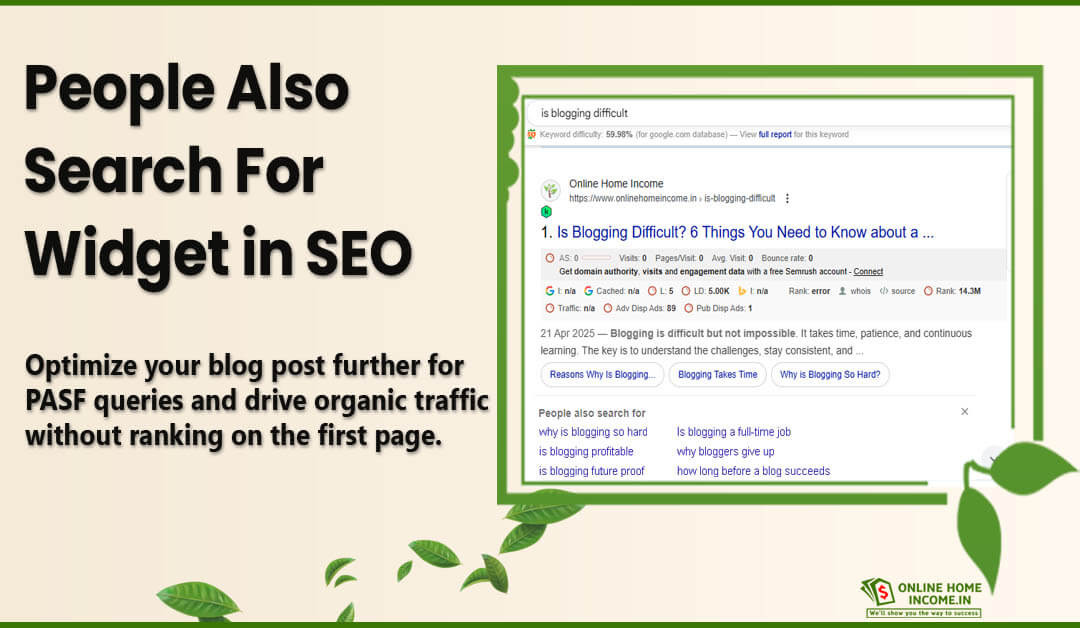You must add a good dose of target keywords in your blog posts for more organic traffic. Let us learn about a category called long tail keywords for improving your blog SEO.
Keywords are an inevitable part of this blogging world. Conducting detailed keyword research is a crucial step before and after publishing posts.
Moreover, keywords are the indices search engine crawlers use to locate your blog.
Then, it gets ranked on search engine result pages (SERPS) based on the relevance of your keywords to search queries.
Keywords are also an integral part of Search Engine Optimization (SEO).
It is responsible for improving the visibility of your blog on SERPS. If you make it to the top 10 search results, your blog will attract organic traffic.
Why is SEO so important to fetch traffic for your blog?
Are there no other shortcuts or roundabouts?
Firstly, SEO is the cheapest yet most high-traffic-attracting marketing option for blogs. This factor helps new bloggers grow and convert viewers to regular followers.
Secondly, SEO relies purely on quality and not merely numbers or statistics. That is why SEO can be a slow process.

SEO filters look for relevance beyond just matching keywords.
Google’s recent Panda algorithm update filters only blogs containing quality content. Thin, repetitive, or insufficient content gets filtered out.
Also, Google’s Penguin update filters out those blogs with low-quality links.
Thus, we now understand how we must refine our SEO process periodically. We will learn how to integrate long-tail keywords in your blog content to improve your SEO.
What are Long-Tail Keywords?
You would have come across the concept of keyword research in blogging. Keyword research refers to choosing a set of words or phrases to include at strategic positions in your blog post.
So, you must conduct keyword research for every blog post you publish. When search engine crawlers find the keywords relevant to user queries, your blog has a high chance of getting an organic rank.
Additionally, crawlers look for such keywords at specific positions in your blog, like the blog post title, meta description, subheadings, URL, etc. Presence in such positions signals higher SEO scores.
So, how do we use these keywords to improve blog quality?
First, let us understand the various kinds of keywords;
Primary keyword – the focus keywords that your blog post is targeting to explain or resolve
Secondary keyword – additional words or phrases that can locate your blog post.
LSI keywords – Latent Semantic Indexing keywords are semantically relevant to your focus keywords.
Long-tail keywords – these are like phrases containing 4-5 words or more.
Long-tail keywords in blog posts:
Consider a blog post with the topic “8 Tips on Mastering the Ragas in Carnatic Music”.
– The primary focus keyword would be – “ragas in Carnatic music”
– Secondary keywords can be – “learning Carnatic music ragas”, “Carnatic music raga hacks”, etc.
– Long-tail keywords can be – “learn sampurna ragas in Carnatic music today,” “learn Carnatic music melakarta ragam classification”
If you observe the above example, you can see that long-tail keywords are more specific and organic.
Such keywords may not have a high search volume.
But when someone is looking for a solution, they put very clear and specific keywords in search queries.
If your blog contains or targets such long-tail keywords for a blog post, you can improve your blog SEO.
As a result, your blog post appears on the top results for an organic search query.
The person who makes this query and arrives at your blog has a high chance of becoming your regular follower. Thus, it is crucial to integrate long-tail keywords in your blog content.
Benefits of Long-Tail Keywords for Blog SEO
All types of keywords are crucial for your blog post. A good quality blog post has a sufficient mix of primary, secondary, LSI, and long-tail keywords.
However, when ranking target pages, SEO algorithms look for high levels of relevance, user satisfaction, blog navigation, content split up, quality, originality, and so on. These reasons are why no search user goes beyond the first page of SERPS.
When you think of how you use long-tail keywords in SEO, you must think of what terms/phrases users use to reach you.
Competing for such phrases in tools like Google Adsense makes your blog visible on ad spaces and search engine results.
Let us see some benefits of using long-tail keywords to let users get to you faster.
Long-tail keyword-optimized blog posts are easier to rank
Such keywords or phrases have less traffic. But should we not use words that attract high traffic?
Why do I suggest using low-traffic, long-tail keywords in blog posts?
Did you know that at least 70% of search queries contain long-tail keywords?
Also, subsequent engagement and clicks are higher on blogs through long-tail keywords.
The reason for long-tail keywords to have low traffic is that they are more specific.
In our example of learning ragas, someone may be in dire need of learning the classical nature of ragas and their classification.
Moreover, long-tail keywords have less competition. As seen above, it is purely in dire and organic situations that users use such long-tail keywords in search queries.
Your target traffic for such keywords may be low, but this can improve your organic traffic over time.
Since SEO as a process is slow and organic, using long-tail keywords for blog SEO can boost your blog’s ranking one fine day.
You can focus on laser-focused targeted traffic
Long-tail keywords, as such, are meant to target particular queries.
Consider our example.
If the new author targets keywords like “Carnatic music”, “Carnatic music ragas”, etc., his blog would be far below many other top pages.
On the other hand, they can target keywords like “learn sampurna ragas in Carnatic music.”
If the blog deals with teaching “sampurna ragas” and the user wants to learn this, the blog will get to the top.
If not the top, you can at least get to the first page of SERPs.
For a beginner blogger, getting to this spot is itself an achievement. This placement will be possible using low-traffic yet highly specific and organic long-tail keywords.
The world is full of people looking for solutions and explanations online.
If your blog has a solution, you must ensure it reaches those searching for it. This traffic could be a minimal volume.
Yet, every visit to your blog makes a difference. When you integrate long-tail keywords in your blog content, you slowly improve your SEO.
Long-tail keywords have better conversion rates
Those coming to your blog out of organic search have a high potential to follow you and become regular subscribers.
Higher engagement results through such traffic because such users have sufficient domain familiarity. Their queries will be valid and to the point.
Say a person is searching for a blog about ways to decorate houses. They are more interested in Chettinad-style house designs.
So, their queries will have long-tail keywords like “Chettinad-inspired house décor.”
If your blog provides ideas for the above query, include and compete for long-tail keywords rather than generic keywords like “house décor”.
Furthermore, better conversion rates improve your authority as a blogger in your domain.
Your blog appears credible, and consequently, your SEO score improves. Thus, long-tail keywords help to increase your blog SEO
How to Use Long-Tail Keywords to Boost Blog SEO?
As a new blogger, you must be ready to face competition in the sea of blogging. Almost every blogging niche has a new blogger coming online every day.
How do you plan to stand out from the crowd?
Also, SEO metrics are becoming strict and focusing on first-hand experiences. Do you have what it takes to overcome this strict blogging challenge in your blogging niche?
Your blog plans to solve a user concern. But do you know who exactly is your organic traffic? Can they get to you easily?
Ultimately, you want to earn a passive income through your blog. Can this be possible?
There are no shortcuts or fast-track methods to achieve any of the above. However, using metrics that can boost your SEO will fetch your blog organic traffic and subsequent exponential revenue.
One of these metrics is making use of long-tail keywords. Let us learn how long-tail keywords for blogs help improve your SEO.
Step 1: Identify User Search Intent
When you start learning how to find long-tail keywords, you must first understand why a user will search and come to your blog.
This intent is most important to generate long tail keywords around your primary keywords.
Search intents are of various types. We will see some examples to give you a self-explanatory experience;
Informational intent (users searching for first-hand information and explanations)
– How to make a blog SEO-friendly for beginners
– Tips to create a website from scratch
Commercial intent (users looking for blogs to learn better before buying something)
– Top 10 bloggers to partner for monetization
– Best gadget review blogs for mobile phones.
Transactional intent (blogs providing updated or live information)
– NSE and BSE stock market analysis live
– Cricket scores for IND v PAK match today
Navigational intent (users looking for blogs with a particular name or title)
– Dasanna recipes paneer butter masala
– Onlinehomeincome how to start your blog
From the above types, you would have understood how long-tail keywords add more value to your focus keywords and blog. Google search comprises more of such specific organic queries.
Moreover, Google uses AI algorithms to list results. Do not stuff long-tail keywords as is at various locations in your blog.
Consider one example above.
A user searches for my blog post by mentioning my blog’s name, ‘Onlinehomeincome.’
If you view that post, ‘onlinehomeincome’ won’t be found anywhere in the content. Therefore, be careful in strategically placing your focus keywords in your blog content.
So, when you decide on your blog post topic, make sure to first jot down the intents with which users can get to your post.
Step 2: Create a List of Long-Tail Keywords
Once you get the search intent, you must move on to the keyword research process for your blog post.
We have already come across the process of keyword research.
Keyword research is no different for long-tail keywords. Generally, long-tail keywords have a low search volume. But, such search queries result in attracting organic traffic from your blog.
Any keyword research tool would give you a good collection of long-tail keywords for your blog topic.
- Google Keyword Planner, SEMRUSH, Ahrefs, etc., are popular keyword planner tools to get a rich list of long-tail keywords.
Then, make a spreadsheet with the above-fetched list of keywords. Excel is a good choice.
For each long-tail keyword, note the search volume, engagement ratio, cost-per-click (CPC for ad purposes), domain relevance, etc. Then, rank and prioritize them in any order.
For the second round, Google each of these keywords and list keywords you can derive from relevant questions. These relevant keywords come in Google’s “People Also Ask” section.
Repeat the same process and keep adding all possible long-tail keyword combinations. You won’t need to worry about SEO, as most results come from tools that boost your SEO.
If this process seems hard, you always have the option of using long-tail keyword generator tools that we will see soon.
Once you are convinced with a sufficient list of long-tail keywords, move on to start using them in your blog post.
Step 3: Prepare a Content Outline
From the list of long-tail keywords you have collected, you must create a blog post outline.
Prepare a plan to treat and optimize your long-tail keywords in the blog post.
Your long-tail keyword list can help you create a list of topics and sub-topics for the current blog post.
This list comes from the natural human instinct that if one query is satisfied, one will come up with another relevant query.
This sequence of relevant queries and subsequently arising long-tail keywords act as perfect building blocks for your blog outline.
Say, I have a blog on learning “sampurna ragas in Carnatic music”. The topic may seem straightforward.
However, we may not know the prerequisite knowledge level of our readers.
Failing to provide the right prerequisites may lead to frequent queries outside your blog post.
As a result, readers can get distracted or may even go away to another blog that provides what they want.
So, if I am writing the above blog, I must keep in mind all the relevant queries and include them as subtopics, like;
- What are ragams in carnatic music?
- How are ragams classified?
- Who was responsible for their classification?
- What are aarohanams and avarohanams?
- What are sampurna ragams and melakartha ragams?
And so on.
Based on relevant queries, prepare your content headers and classify them across header tags in your blog post.
Step 4: Start Writing the Blog Post
Let us see how to integrate long-tail keywords into your blog content. It is good practice to write in-depth, long-form blog posts.
But won’t lengthy blogs and a lot of text content make us lose interest? you may ask.
- You must remember that the first readers of your blog are the search engine crawlers.
- Post these, your blog must pass through numerous SEO filters and meet their standards.
According to SEO standards, search engines value blog posts with a word count of at least 2500 words.
If blogs go low on text, search engines regard them as thin or poor quality, ultimately going way below SERPs.
So, to stay at the top of your game, you must write lengthy yet highly informational blog posts.
When you have lengthy content, sectioning your text into various topics is important.
If you are targeting long-tail keywords for blog SEO, you must include them in strategic positions.
- Your blog post title, subheadings, first 100 words, last 100 words, image ALT text, etc., are good places to include long-tail keywords.
- Also, try to include them in at least 4 sub-headings and once in every 500 words.
- The key is to make long-tail keywords appear natural in your blog content.
Forcefully stuffing keywords just to meet SEO requirements can result in your blog fetching a negative SEO rank.
Step 5: Long-Tail Keywords on Meta Tags
Your blog’s HTML code contains the meta section that has a title and a description.
The meta title refers to the text you see on search results. Below this comes a line or two of descriptive text called the meta description.
You will also find the meta title at the top of your browser’s tab when reading the blog.
This meta title is the main factor to grab the user’s attention in a span of milliseconds.
A relevant and attractive meta title can prompt the user to click on your blog post from SERPs immediately.
We have seen how to create optimal meta titles in some of my previous posts.
The meta title is one of the best places to use your long-tail keywords in SEO.
As we already know, meta titles are one of the crucial SEO metrics used by search engines to rank blogs.
The more relevant your meta title is to the user’s organic query, the higher your chances to rank higher.
Similarly, the meta description gives a quick gist about your blog post in 1-2 lines.
This text appears just below the meta title on SERPs. Optimizing this descriptive text with your long-tail keywords helps users understand that your blog has what they seek.
Search engines mainly use meta titles and descriptions to check relevance and rank your blog.
Since long-tail keywords are more specific and have a higher audience engagement rate, it is only wise to include them in your meta titles and descriptions.
Step 6: Create Sub-Headings Using Long-Tail Keywords
It is important to section your blog content into several sub-headings. This sectioning is important to help viewers pause and take breaks from lengthy and wordy blog posts.
Each section must have a suitable subheading.
HTML website development standards provide header tags to help bloggers add sufficient headings and subheadings in a top-down manner.
These tags and their sizing help users differentiate the top-level heading and one or more sub-headings under the topic.
What is so special about these headings?
Did you know that search engine crawlers browse through these header tags? They check for keywords in the heading text.
One or more occurrences of long-tail keywords in your subheadings are a boost for blog SEO.
Long-tail keywords in header text signal that they have the exact content a user searches for. As a result, your blog rises to the top ranks of SERPs.
So try adding long-tail keywords in all possible H2 and H3 headings in your blog post.
However, adding them to irrelevant places can result in a negative SEO score. Such keyword stuffing at various places to achieve good keyword density is a bad blogging practice.
If you are unsure of framing your headings, you can use headline analyzer tools. These tools help to optimize your headlines for long-tail keywords.
Step 7: Add Long-Tail Keywords by Updating Old Blog Posts
As much as search engines look for quality content, they look for blogs that have been published most recently.
This metric ensures that users get the latest information on whatever they seek.
Your blog may have what a user wants. But if it was published years ago, there is a chance a new blog with a more recent publishing date will provide the same solution.
That is why it is important to update your blog content periodically, say once every 4-6 months. If you do not have many changes to your content information, you must pay attention to keywords.
Keyword usage trends change over time. What users may have used to get to your blog earlier may no longer be relevant now.
The same goes for your long-tail keywords. To analyze this pattern, you can use the Google Search Console.
This tool performs several operations in analyzing your blog’s performance on Google search.
One of the features is that it will help you understand what queries lead users to your blog posts.
From this list and the latest keyword research results, you will get a new list of long-tail keywords for blog SEO.
Then, start adding and updating your existing blog posts.
To know the queries coming to your blog;
- Go to Google Search Console and type your blog domain
- Under the “QUERIES” tab, look for the top 1000 queries for your blog.
- Check for different combinations of keywords using the filters in Queries.
- Derive new lists of long-tail keywords for your blog.
Long-Tail Keywords Generator
You may get a few long-tail keywords on your own or from keyword research. However, it is difficult to get the exact keywords used for searching for something across various parts of the world.
However, tools are available today to derive all possible long-tail keywords.
Long-tail keyword generators help in getting a huge list of possible long-tail keywords. Also, these tools show the performance and engagement for each keyword.
Based on the performance, choose low-traffic yet high-quality ones and integrate long-tail keywords in your blog content.
Let us learn about some popular long-tail keyword generator tools.
Google Search Feature
The auto-complete feature of Google Search gives you a list of possible queries that follow a user-entered phrase.
Type the following phrase: “How to cook paneer”.
You will get a list of suggestions to complete your query, like;
– At home
– In a microwave
– Butter masala
And so on.
Discover People Also Search For Widget (PASF Widget) and collect the keywords list.
However, auto-complete is not influenced by Google Trends. This feature is purely based on your search patterns and possible future searches.
Google search learns from your browsing patterns to provide relevant suggestions to auto-complete your queries.
Such auto-completed queries give you a huge list of long-tail keywords for improving your blog SEO.
Google People Also Ask
This feature comes on the first page of SERPs to allow users to learn additional queries related to their search queries.
The ‘People Also Ask’ queries are the best sources to find relevant queries. These relevant queries act as good choices for long-tail keywords.
Since People Also Ask contains popular queries on a particular topic, including them as your long-tail keyword phrases can improve your organic traffic.
Try to include similar queries as sub-topics within your blog post.
If you address similar queries on a topic in your blog post, you can reduce the bounce rate from your blog.
Furthermore, addressing relevant long-tail keywords can increase engagement and followers for your blog.
Analyze the blog or pages listed as solutions for People Also Ask queries. Also, analyze how they naturally add long-tail keywords to their posts.
In most cases, you will find that they give straightforward answers to such queries.
So, try following the same practice when handling long-tail keywords of user queries. This way helps to improve your blog SEO.
SEMRUSH Topic Research Tool
This tool from SEMRUSH helps bloggers and content writers explore various topics and sub-topics in their given domain.
All you must do is enter a topic in the search bar. You get flooded with various related and detailed topics that you can cover.
When performing keyword research, you must ensure that your long-tail keywords have the potential to get listed for organic searches.
Long-tail keywords rely more on a topic’s importance and user intent than keyword popularity.
This tool lets you know the important and trending topics that users are currently searching for.
You get to see the top-shared headlines in your domain. You can also get a list of top queries and questions on your blog topic.
Moreover, the search results that come here are purely aligned with SEO benefits. So, pick out the best options with this long-tail keyword generator tool.
Leverage Online Forums
You can use social media, forums like Quora, and other discussion pages to find a rich list of long-tail keywords.
These pages contain suggestions and relevant queries for every blogging topic.
Social media discussion groups are popular hotspots for everyone in the blogging community.
Bloggers use their Facebook groups, YouTube channels, Instagram Threads, X-tweet threads, etc., to have organic discussions with their followers.
One can get ample topic and sub-topic ideas through such healthy discussions.
Queries and questions arising from such discussions make for high-traffic-attracting long-tail keywords.
These queries may still have the potential for bloggers to explore and develop new solutions. So, make use of these opportunities and integrate long-tail keywords in your blog content.
Q&A forums like Quora have answers to any user query. Like People Also Ask, Quora has its list of relevant questions that come along the answer list for a query.
Such topic correlations give you a good list of long-tail keywords for blog SEO.
Google Keyword Planner
This is one of the top keyword research tools that help you to monetize your blog gradually. Using this tool, you can get a list of keywords and how your competitors bid for them.
When you bid for a keyword, your blog gets listed in Google Ad spaces in relevant blogs or websites.
Bidding for high-traffic keywords would mean you have to be with a vast sea of bloggers.
We already know that long-tail keywords attract low traffic but are highly organic. You can use Google Keyword Planner to generate a list of long-tail keywords relevant to your blog topic.
From these results, choose low-traffic yet accurately relevant keywords that can make your blog appear unique.
Consider the example of home décor we saw above.
Amidst rising competition, your blog has better chances to rank for the keyword “Chettinad-inspired home décor” over “popular home décor.”
Conclusion
When you publish a blog post, include relevant keywords to get a high SEO rank. Including long-tail keywords is a great way to improve your blog’s SEO.
SEO ensures that the results for your search queries meet your expectations. The top 10 results are tailor-made for solving our queries. In most cases, the first 1-4 results itself help us.
As a result, search engines are very strict about the quality of blogs and websites that reach the top of search results.
One of the primary ways to achieve this is to integrate long-tail keywords in your blog content.
Long-tail keywords are generally low-traffic or less popular when compared to trending keywords.
However, these are highly engaging and bring you the most organic traffic for your blog.
Firstly, one must understand the user’s intent when searching for their blog post. Based on the intent, you can frame a list of long-tail keywords.
Various long-tail keyword generator tools are available to aid you with the same.
Next comes planning your content and blog outline.
Based on the long-tail keywords, create various topics and subtopics that you address through your blog.
Then comes the actual insertion of the keywords. Insertions must happen at strategic locations like your heading titles, meta tags, etc., to enable search engines to find you more easily.
Moreover, insertions must not appear stuffed. They must appear natural along with the flow of your blog.
Finally, regularly update your blog content based on user’s search patterns.
So do not skip including long-tail keywords in your blogs to ace your SEO game.








